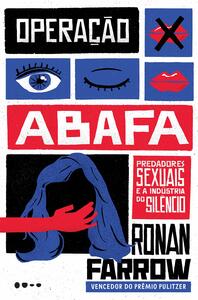Take a photo of a barcode or cover
challenging
dark
emotional
informative
reflective
sad
tense
medium-paced
dark
informative
medium-paced
This may be my favorite book of the year, even the decade. I just have so much respect for Ronan Farrow. He and his associate McHugh withstood so much b.s. at NBC to nurture this #metoo story to fruition. Ultimately, it was the women who were willing to share their stories about Harvey Weinstein and his serial predator ways that saved the day. Oh, AND it's about the spies who were hired by Weinstein and his coverup crew that try to discredit the victims, Farrow, and anyone else in their way. It's about corruption at the top levels of NBC (seriously sickening), politics, the NY DA's office, Hollywood, and their pathetic lawyers and handlers who insulate Trump, Matt Lauer, Tom Brokaw and others with pay-offs and non-disclosure agreements to the women they attacked and who's professional and sometimes personal lives they ruined. This is about blood money and lots of it.
You think you know this story, but you HAVE to read this book. Farrow puts the reader right in the thick of his life while reporting on this. I am now a fan of Ronan Farrow (won't you run for President??!!), and I am so impressed with his ability to have teased out the very words and quotes from those in power that Farrow exposed to make this book and this movement such a success. Weinstein is up for trial in New York in just a few days, and Farrow's reporting should take him down. I'm anxious to see just how much Weinstein's money and lawyers can buy for him given the undeniable facts laid out in this book. The speed with which this book came to press and the readability of it are pure gold. Farrow has writing chops! Do not miss this book!! Oh, and The Catch and Kill Podcast with Ronan Farrow by Pineapple Street Studios at https://podcasts.apple.com/us/podcast/the-catch-and-kill-podcast-with-ronan-farrow/id1487730212 is also spectacular.
You think you know this story, but you HAVE to read this book. Farrow puts the reader right in the thick of his life while reporting on this. I am now a fan of Ronan Farrow (won't you run for President??!!), and I am so impressed with his ability to have teased out the very words and quotes from those in power that Farrow exposed to make this book and this movement such a success. Weinstein is up for trial in New York in just a few days, and Farrow's reporting should take him down. I'm anxious to see just how much Weinstein's money and lawyers can buy for him given the undeniable facts laid out in this book. The speed with which this book came to press and the readability of it are pure gold. Farrow has writing chops! Do not miss this book!! Oh, and The Catch and Kill Podcast with Ronan Farrow by Pineapple Street Studios at https://podcasts.apple.com/us/podcast/the-catch-and-kill-podcast-with-ronan-farrow/id1487730212 is also spectacular.
dark
emotional
informative
mysterious
medium-paced
I read the physical book and it took me a while to get into it, But about half way in, it picked up and I really wanted to keep reading.
But also ugh. It is wild how people can be such predators and no one feels brave enough to stop them.
But also ugh. It is wild how people can be such predators and no one feels brave enough to stop them.
dark
emotional
informative
mysterious
tense
fast-paced
This is a truly engrossing narrative. Ronan Farrow writes well, has a wry sense of humor, and is careful to clarify what he knows and what he's heard. It's a page-turner that offers a clear view of Weinstein's (and other's) abusiveness and the lengths to which he has gone to intimidate his victims and to hide evidence.
challenging
dark
emotional
informative
reflective
medium-paced
Difficult but excellent read. The audiobook version has actual audio evidence which was bone chilling.
Graphic: Emotional abuse, Sexism, Sexual assault, Sexual harassment
dark
informative
mysterious
medium-paced






